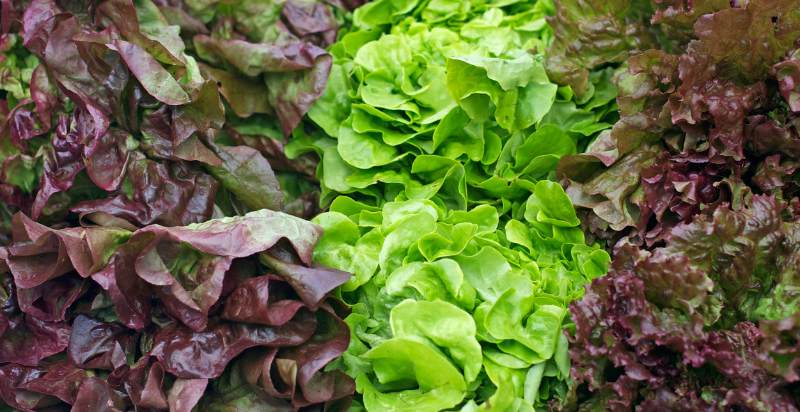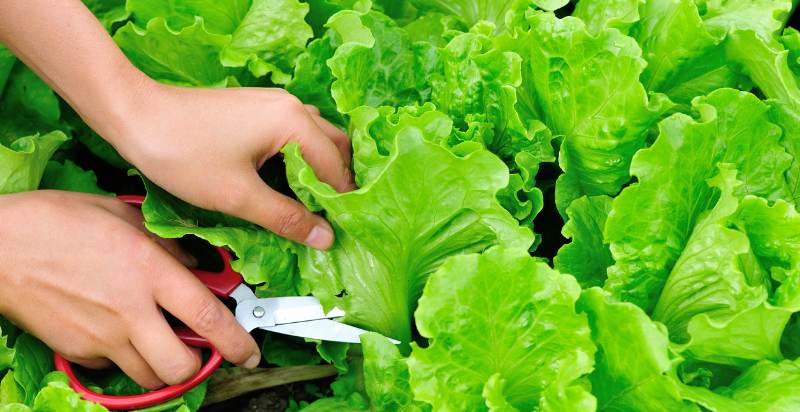Lettuce is an incredibly versatile vegetable that can be used in a variety of dishes. Its crunchy texture and mild flavor make it an ideal ingredient for salads, wraps, sandwiches, soups, and more. Wide lettuce varieties are available today, with unique flavor and texture profiles. Here is everything you need to know about lettuce, from its different varieties and their preparation methods to its health benefits.
What is Lettuce?
Lettuce is a leafy vegetable belonging to the Asteraceae family, including artichokes, endives, and sunflowers. It originated in Europe and has been cultivated for thousands of years. The most common type is head lettuce because it forms a tight head when mature. Other varieties include leaf lettuce, which is more loosely packed, and romaine lettuce, which has a crunchy texture.
Types of Lettuce:
There are several different types of lettuce available on the market today. The most common types are iceberg, butterhead, and romaine. Iceberg lettuce is known for its crisp texture and mild flavor, while butterhead is more delicate and sweet. Romaine lettuce has a crunchy texture and is often used in Caesar salads. Other types include red, green, oak, and lollo rosso.

History and origin of Lettuce:
The earliest known reference to lettuce dates back to 4500 BC in ancient Egypt. It was used by the ancient Greeks and Romans, who believed it had medicinal properties. Lettuce spread throughout Europe during the Middle Ages and was eventually introduced to North America in the 16th century. Today, lettuce is a popular ingredient in salads, sandwiches, tacos, and other dishes.
Nutritional Value of Lettuce:
Lettuce is an excellent source of several essential vitamins and minerals. It’s rich in vitamin A, which helps to maintain healthy skin and eyesight. It also contains vitamin K, which is important for bone health, and folate, which the body needs for proper cell growth. Lettuce is a good source of dietary fiber, which helps to keep the digestive system healthy and regular.
Health Benefits of Lettuce:
Lettuce is a low-calorie food that can provide numerous health benefits. It’s rich in antioxidants, which can help reduce inflammation and protect cells from damage. Eating lettuce can also help to lower cholesterol levels and reduce the risk of heart disease. It’s also a great source of dietary fiber, which can help to improve digestive health.
How to Plant Lettuce?
Lettuce is a nutritious, low-calorie, and versatile vegetable that is easy to grow. You can successfully plant lettuce in your garden or containers with a little knowledge. Here are the steps for how to plant lettuce:
Step 1: Choose Your Variety
Before planting lettuce, choose the variety you want to grow. Various varieties include butterhead, romaine, oak leaf, and crisp head lettuces. Consider your family members’ taste preferences and the available space before selecting a variety.
Step 2: Prepare The Soil
Once you have chosen a variety, prepare your soil for planting by loosening it with a rake and adding any necessary amendments, such as compost or fertilizer. It is important to work the soil until it is fine and free of clumps before planting lettuce.
Step 3: Plant The Seeds
Lettuce seeds should be planted at a depth of 1/4 inch. Space the seeds two inches apart in rows spaced 12 inches apart. Once you have planted your seeds, cover them with a thin layer of soil and lightly pat them down.
Step 4: Water The Soil
Water the lettuce seedlings immediately after planting, ensuring the soil is moist but not saturated. Avoid over-watering, as too much water can cause the seeds to rot before germinating. Over-watering can also cause disease in the lettuce plants.
Step 5: Thin The Plants
When your lettuce seedlings are approximately two inches tall, thin them by lightly pulling out every other plant. This will give the remaining plants room to grow and ensure they receive adequate sunlight and nutrients.

Step 6: Fertilize & Weed
Fertilize your lettuce plants with an all-purpose fertilizer once a month during the growing season. Weeding is also important — remove any weeds that may compete with your lettuce for resources like water and sunlight.
These steps allow you to learn how to plant lettuce in your garden or containers. Once you master this skill, you can enjoy a variety of homegrown lettuce throughout the season. Enjoy!
How to Care for lettuce?
Here are steps to take care for lettuce:
Step 1: Water
Water lettuce regularly, ensuring the soil is consistently moist but not soggy. An inch of water per week should be sufficient during summer. You may need to water more often in very hot climates and less often in cooler climates.
Step 2: Fertilize
Fertilize your lettuce plants every three weeks with a balanced fertilizer that contains nitrogen, phosphorus, and potassium. Make sure to follow the instructions on the packaging for proper application amounts.
Step 3: Mulch
Mulching around lettuce plants helps retain moisture, reduce weeds, and protect against temperature extremes. Organic materials such as straw or bark chips make great mulches for lettuce.
Step 4: Pest & Disease Control
Check your lettuce plants regularly for signs of pests or diseases. If you spot any, take action to treat the problem early on. Common lettuce pests include aphids, caterpillars, and beetles. Common diseases are downy mildew and bacterial leaf spot.
Step 5: Harvest
When the lettuce leaves appear crisp and full, it’s time to harvest. Cut off the entire head of lettuce at the base with a sharp knife or scissors. Make sure to leave some of the stem attached so other leaves can still grow from it if desired.
Step 6: Store
If you have more lettuce than you can eat in one sitting, store the extra in a plastic bag in the refrigerator. When properly stored, lettuce should stay crisp and fresh for up to five days. If you’d like to freeze it, blanch it first by placing the leaves in boiling water for two minutes before cooking them quickly with cold water. This will help preserve its color and texture. Frozen lettuce should last several months when properly stored.

Bonus Tip: Plant Your Lettuce in the Shade
If you live in a hot climate, try planting your lettuce in a shadier spot. This will help protect it from the sun’s extreme heat and reduce its chances of wilting or bolting. Also, if you plant later in the season, choose a spot that gets shade during the hottest parts of the day. This can help keep your lettuce cooler and tastier for longer!
Preventions From Pests and Diseases:
Step 1: Sanitation
The best way to prevent pests and diseases from affecting your lettuce plants is to practice good sanitation. Remove dead leaves, weeds, and other debris from around the plants and keep the surrounding area free of these materials.
Step 2: Rotate Crops
Rotating crops helps reduce disease pressure. Planting lettuce in a different spot each season can help prevent diseases like downy mildew and bacterial leaf spot that previous crops may have left behind.
Step 3: Choose Disease-Resistant Varieties
When planting lettuce, opt for varieties that are known to be disease-resistant. For example, some romaine lettuce is bred specifically to resist downy mildew.
Step 4: Monitor for Pests & Diseases
Check your lettuce plants regularly for any signs of pests or diseases. Taking action early on can help reduce the severity of any problems and protect future harvests.
Bonus Tip: Use Organic Sprays
If you do find that pests and diseases are affecting your lettuce plants, use organic sprays to treat them instead of chemical pesticides. This will avoid harming beneficial bugs in your gardens, like bees and ladybugs, while still helping to keep your lettuce healthy. Following these steps can ensure a successful harvest of delicious homegrown lettuce.
How to Harvest Lettuce Plant?
When the lettuce leaves appear crisp and full, it’s time to harvest. Cut off the entire head of lettuce at the base with a sharp knife or scissors. Make sure to leave some of the stem attached so other leaves can still grow from it if desired. If you have more lettuce than you can eat in one sitting, store the extra in a plastic bag in the refrigerator for up to five days. You can also freeze your lettuce by blanching it before storing it for longer. Finally, don’t forget to give thanks for all those delicious homegrown vegetables! Thanks for reading!

How to Store Homegrown Lettuce Plants?
If you have more lettuce than you can eat in one sitting, store the extra in a plastic bag in the refrigerator. When properly stored, lettuce should stay crisp and fresh for up to five days. If you’d like to freeze it, blanch it first by placing the leaves in boiling water for two minutes before cooking them quickly with cold water.
This will help preserve its color and texture. Frozen lettuce should last several months when properly stored. Using airtight containers or bags to prevent freezer burn and keep your lettuce as fresh as possible. Thanks for reading!
How to Use Lettuce?
There are so many delicious ways to enjoy lettuce! It can be used as a base for salads, stir-fries, sandwiches, wraps, and more. Lettuce is also great in smoothies and even juices. Try incorporating lettuce into your meals for an added nutritional boost and extra crunch. Thanks for reading!
Bonus Tip: Use Different Varieties
Don’t just stick to one type of lettuce — try different varieties! There are many kinds available at most grocery stores or farmer’s markets. Iceberg lettuce is the most common variety, but others like Romaine, Butterhead, and Oakleaf have unique flavors. Mixing up your ingredients can take your dishes to the next level! Thanks for reading!

Potential Risks from Lettuce:
Eating lettuce can have potential risks, especially if it is not properly washed or stored. It’s important to ensure that any lettuce you eat has been washed thoroughly to remove any dirt and bacteria. Check the expiration date on pre-packaged lettuces, as they may contain harmful bacteria after their expiration date. Additionally, store lettuce in a cool environment and consume it within five days of purchasing it for maximum freshness.
Conclusion
With proper care, your lettuce plants can be a tasty and nutritious addition to any meal. Regularly plant in full sun and water and monitor for pests and diseases. When it’s time to harvest, cut off the head of lettuce at the base, leaving some stem attached so other leaves can continue growing. Store extra lettuce in the refrigerator or freeze it for long-term use. Finally, don’t forget to try different varieties of lettuce for added flavor and nutrition to your meals!
You can have delicious homegrown lettuce throughout the fall and winter months with just a little effort. Remember to take proper precautions when harvesting, storing, and using lettuce for the best possible results.
- Everything you wanted to know about Green Tiger Tomatoes. - April 1, 2024
- Everything you wanted to know about Atomic Grape Tomatoes . - April 1, 2024
- Plum Types and Varieties: A Comprehensive Overview | GardenersMag . - April 1, 2024

16 thoughts on “Growing Lettuce: How to Plant, Care, and Harvest Lettuce”
Comments are closed.